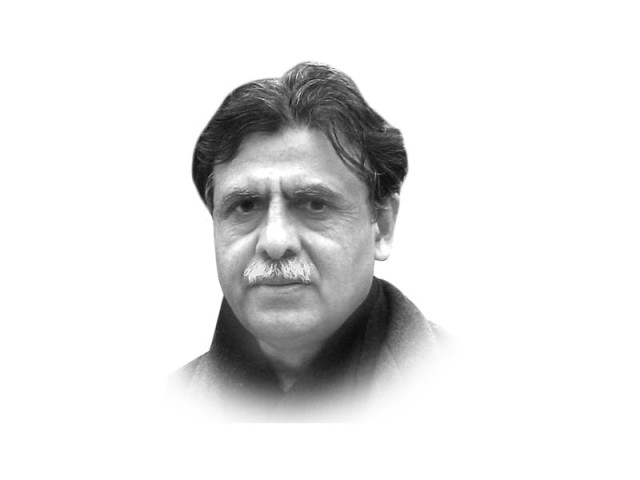Grim December
December reminds us of the painful drop scene when some 45 years ago Pakistan flag was lowered at Ramna Green, Dhaka

The writer is an author, alumnus of Dhaka University and a public policy analyst. He is a former federal interior secretary and teaches at LUMS
The centrist leadership mostly hailing from UP and Punjab had little time to share and empathise with the sensitivities of people living away from the mainland despite being in majority. The centrist narrative, however, failed to undermine the strong undercurrents that desired regional autonomy, as well as political and economic space. In those impressionable years that I spent in the then East Pakistan, I do not recall any discernible secessionist vibes or any demand for an outright break from Pakistan. The basic discourse was that as Bengalis were in majority, they had every right to design the future political landscape so that their essential rights could be secured. The prevalent system was equated with internal colonialism wherein East Pakistan was the periphery to serve the interest of the core, the western part of the country, and policies in all the key fields were designed and executed towards that end.
In our early years of struggle for independence, the two nation theory provided the requisite steam to propel the Muslims of the subcontinent towards a common platform. This ideological plank created an abiding link amongst Muslims from different geographic domains and ethnic backgrounds. Essentially, Muslims were perceived distinguishable from the Hindus in terms of their political and economic rights. The renowned Bengali leader, Hussein Shaheed Suhrawardy, in his early years for the struggle of Pakistan, was wedded to the same idea. After the creation of Pakistan he was prepared to allow for more flexibility in the concept to square with the new realities. He felt that any further push to the ideological narrative would have a spiral effect and it was time to give more space to emerging political and economic imperatives. Mere ideology would not lead the nation anywhere as other essentials were also required. To the native intelligentsia, Bengali Muslims were distinguishable from the Hindus, like other Muslims of the subcontinent, but after independence they were also distinguishable from other Pakistani Muslims when it came to securing their cultural, political and economic rights. The language movement added a new perspective to the struggle and gave a distinct impetus to the Bengali cause. Subsequent events suggest that the distinct Bengali ethnicity reinforced by geographical separation and accentuated by uneven economic development led to a lethal mix as we continued to delay coming to an agreement on a national compact in the country. The economic model being pursued provided a functional justification for inequality in income generation. According to this reasoning, the road to equality lay through a recourse to inequality. As a consequence of this paradigm, economic disparity in the country widened while institutional biases provided more opportunities for growth and investment in West Pakistan. Economic unevenness was further skewed through concentration of political power and decision-making in the hands of the political and bureaucratic elite hailing from the western part of the country.
Pakistan was able to steer its way through with a consensus on the 1956 Constitution wherein the Bengali leadership accepted the principle of parity in political and economic fields and conceded their majority. Suhrawardy deserved credit for rallying the Bengali sentiment on the agreed document which promised hope and a sense of direction to the country. What was now needed was the provision of a fair chance to the agreed upon scheme of things. The grand idea, however, was subverted with the promulgation of martial law and abrogation of the Constitution in 1958. Ten years of authoritarian rule, while delivering on certain economic fronts, created a deep wedge and alienation amongst the people of the different regions of Pakistan. It created a breeding ground for growing fissiparous tendencies.
The 1965 war was a watershed moment, as the East Pakistan-based Awami League capitalised on the situation and came up with a six-point programme for the country’s political future. The iteration of faith in the federal system was with a difference and the central government was to be confined to just two subjects, defence and foreign affairs, with the provinces having complete power over imposition of taxes and defraying the expenses of the centre. In other words, the six points wanted the central government to be dependent on the provinces to meet its daily expenses, with there being two separate central banks for the provinces. From 1966 till 1970, despite being incarcerated, Sheikh Mujibur Rahman became the undisputed Bengali leader and was able to garner political support for his programme. It became an election plank in the 1970 general elections. The military government of Yahya Khan, under the legal framework order, implicitly recognised the six points as a political charter while allowing the Awami League to carry out its marathon election campaign. The party’s broad sweep in East Pakistan turned the six points into a non-negotiable public compact with far-reaching implications for the four federating units in west Pakistan after the break-up of One Unit. Perhaps no one realised the implications in this regard. The six points envisaged a confederal rather than a federal scheme of things and no one in the western part of the country seemed to be ready for this. A complex political problem was subjected to an administrative and later on to a military solution which spelt disaster for the country.
Of late, Pakistan has come of age with there being trust in the politics of bargain amongst its different regions and ethnic groups. We still live in very uncertain times. The threat from within is as pervasive as is the threat from outside our borders. There is, however, a better understanding of the existential threat we face. As a geographical entity and as a compact bloc, we are far more viably placed than we were in the 1970s. That should not, however, cause any smugness as geographical compactness also requires political and economic supplements to ward of untoward turbulence. The country needs to work towards that end on a long-term basis.
Published in The Express Tribune, December 16th, 2016.
Like Opinion & Editorial on Facebook, follow @ETOpEd on Twitter to receive all updates on all our daily pieces.
















COMMENTS
Comments are moderated and generally will be posted if they are on-topic and not abusive.
For more information, please see our Comments FAQ